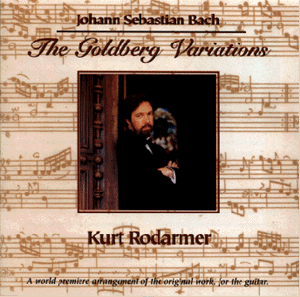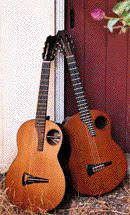
July, 1996
Featured Artist
Kurt Rodarmer
 | Famous Guitarmaker Internet World Headquarters July, 1996 Featured Artist Kurt Rodarmer |
 | A world premiere arrangement of the original work, for the guitar. | ||
On the music...


On the recording
A look back
Some time ago, my father -- a Glenn Gould fan -- offered a seemingly innocent suggestion that was to become my obsession: The Goldberg Variations on guitar.the guitars
I approached the renowned American guitar maker Richard Schneider, who was intrigued with the project. The goals were demanding. I needed a guitar with a bass register extending down into the ranges of cello and double bass. The musical quality had to be consistently excellent throughout the extended range. Many attempts to construct guitars with an extended bass register had lacked in musical quality. With some other type of music, perhaps I could have used readily available instruments, but the Goldberg Variations mandated a radically new guitar. As it turned out, I commissioned two. . . | At last, gaining confidence that the technical problems were solvable, I was able to address the most important element, the music.
I love this music, When I hear or play The Goldberg Variations, I feel the sublime greatness of mankind running through my veins. They have given me a chance to stand in the light of Bach's genius with my own instrument. -- Kurt Rodarmer
|
| the Variations | ||
| 1. | Aria | (2:50) |
| 2. | Variation 1 | (2:13) |
| 3. | Variation 2 | (1:30) |
| 4. | Variation 3 | (2:00) canon on the unison |
| 5. | Variation 4 | (1:02) |
| 6. | Variation 5 | (1:20) |
| 7. | Variation 6 | (:58) canon on the second |
| 8. | Variation 7 | (2:45) |
| 9. | Variation 8 | (1:53) |
| 10. | Variation 9 | (1:21) canon on the third |
| 11. | Variation 10 | (1:24) fuguette |
| 12. | Variation 11 | (2:04) |
| 13. | Variation 12 | (2:15) canon on the fourth |
| 14. | Variation 13 | (5:29) |
| 15. | Variation 14 | (2:21) |
| 16. | Variation 15 | (4:27) canon on the fifth |
| 17. | Variation 16 | (2:06) overture |
| 18. | Variation 17 | (2:04) |
| 19. | Variation 18 | (1:30) canon on the sixth |
| 20. | Variation 19 | (2:16) |
| 21. | Variation 20 | (2:03) |
| 22. | Variation 21 | (2:58) canon on the seventh |
| 23. | Variation 22 | (1:26) |
| 24. | Variation 23 | (2:06) |
| 25. | Variation 24 | (2:26) canon on the octave |
| 26. | Variation 25 | (4:40) |
| 27. | Variation 26 | (2:01) |
| 28. | Variation 27 | (1:56) canon on the ninth |
| 29. | Variation 28 | (1:43) |
| 30. | Variation 29 | (2:15) |
| 31. | Variation 30 | (1:49) quodlibet |
| 32. | Aria da capo | (3:29) |
| total time 73:36 | ||
Transcription, arrangement, performance, & production:
Kurt Rodarmer
Instruments:
Richard Schneider
Album concept and design:
Kiki La Porta
Recorded at Highland Studio Studios, Los Gatos, California
® 1996 Pangaea Productions, PO Box 3289 Santa Clara, CA 95055
All Rights reserved
Unauthorized duplication prohibited by law.
Compact Digital Audio
For more information please contact Pangaea@ppr.com
Featured Artist, July 1996, Kurt Rodarmer
famous guitarmaker internet world headquarters site maintained by cyboboy@cybozone.com